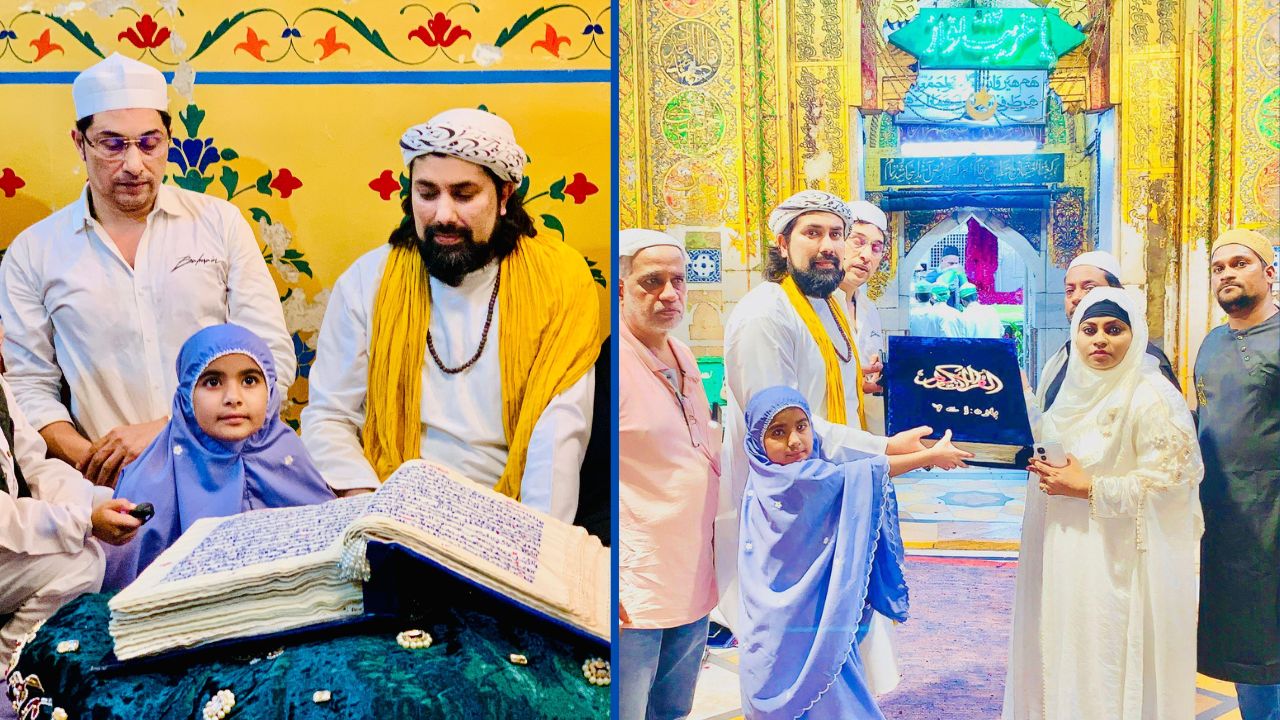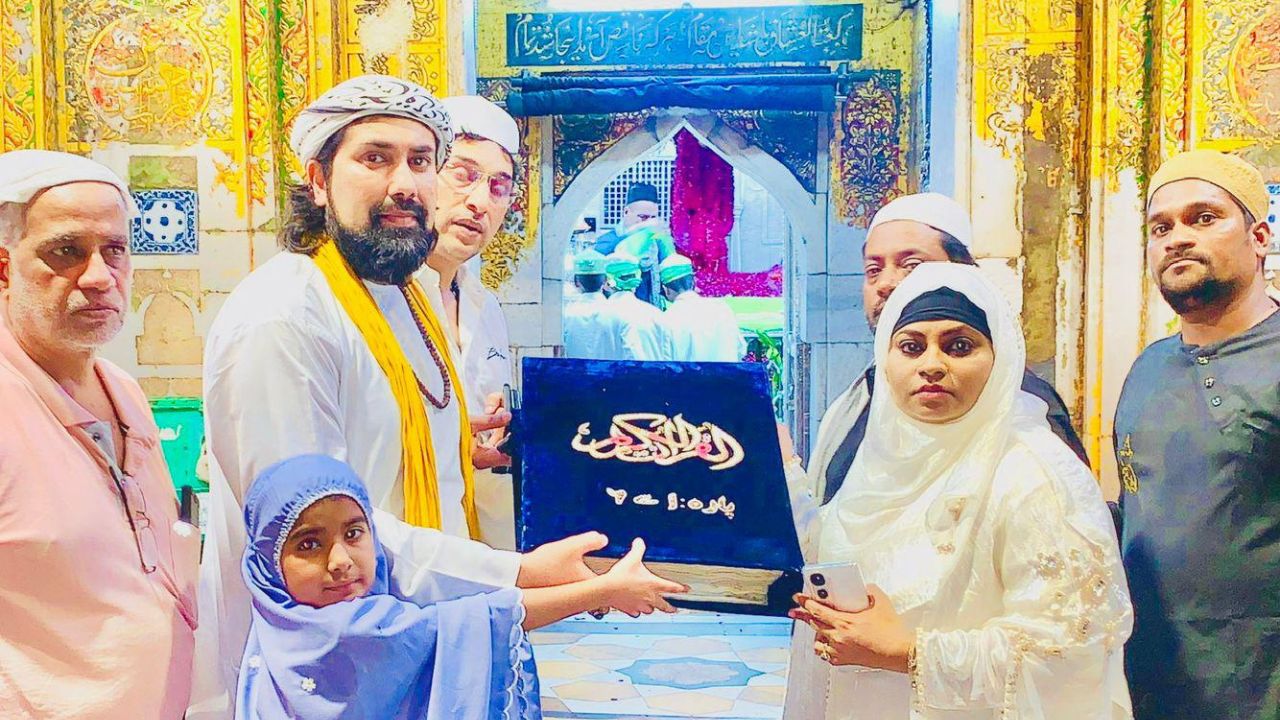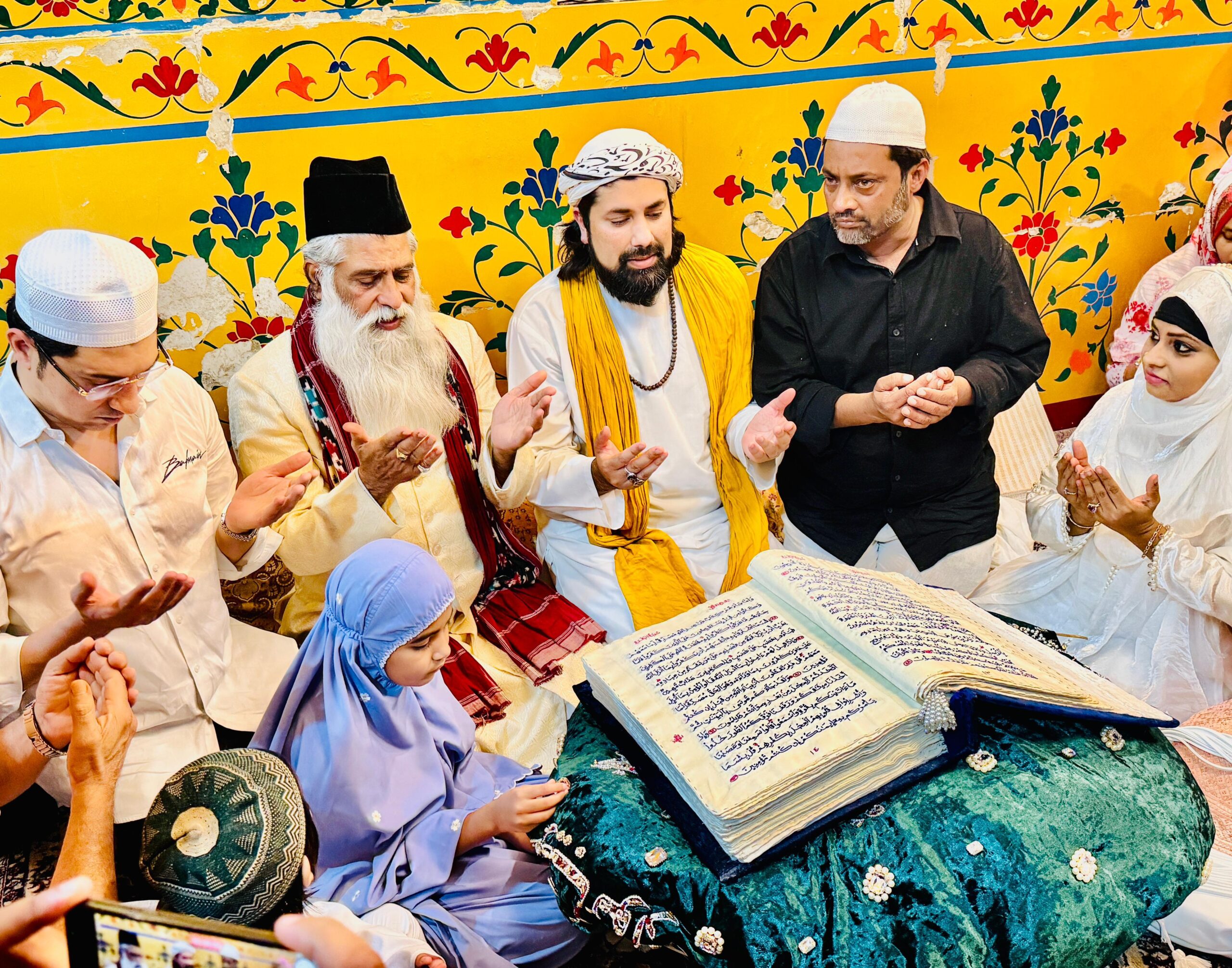Ajmer Sharif: In a gesture that stitches together faith, artistry, and diplomacy, a remarkable artifact is poised to travel from the heart of India to the sacred soil of Saudi Arabia. This isn’t just any book; it’s a meticulously crafted, fully handwritten copy of the Holy Qur’an, inscribed entirely on cloth, and bound in five volumes.
The journey of this unique manuscript began in Bengaluru, where two devoted sisters, Suraiyya Quraishi and Bibi Tabassum, poured six years of their lives into its creation. Their dedication culminated in a powerful expression of spiritual devotion that has now captured the attention of national leaders. The aim is to propose this sacred work as an official gift from India to the Kingdom of Saudi Arabia, destined for the Holy Qur’an Museum in Madinah.

A Six-Year Labor of Love
The creation of the Qur’an on cloth is a testament to extraordinary patience and artistic skill. Over half a decade, the sisters transformed specially treated fabric into 604 pages of divine text. The result is a masterpiece of calligraphy, bound into five distinct volumes.
The choice of cloth as the medium adds a layer of tactile reverence. While paper is the standard for modern manuscripts, writing on fabric harks back to ancient traditions, offering a sense of permanence and intimacy. Each letter, each verse, is a physical embodiment of their deep respect for the Holy Book.
This isn’t merely a religious undertaking; it’s a profound act of spiritual artistry. It bridges the gap between the earthly realm and the divine, executed by hands driven by faith.

A Moment of Reverence at Ajmer Sharif
Sisters presented their sacred gift at the revered shrine of Hazrat Khwaja Moinuddin Hasan Chishty (R.A.) in Ajmer Sharif, a place synonymous with Sufi spirituality and communal harmony in India.
The atmosphere was electric with devotion. Hundreds of followers gathered in the courtyard of the Ajmer Dargah for a rare opportunity to view the manuscript—a practice known as ziyarat. The presence of the cloth Qur’an in such a historically significant spiritual center amplified its meaning, drawing the community closer in shared reverence and prayer.
The presentation was attended by prominent figures of the Chishty lineage, including Haji Syed Salman Chishty, Syed Zahoor Baba, Syed Mehraj Chishty, and others, underscoring the deep respect the community holds for the sisters’ work.
From Devotion to Diplomacy: A Symbol of Indo-Saudi Ties
The vision to transform this private act of devotion into a diplomatic gesture came from Haji Syed Salman Chishty, Gaddi Nashin of Dargah Ajmer Sharif and Chairman of the Chishty Foundation. Recognizing the manuscript’s profound significance, Chishty has proposed that the Government of India present it as a formal gift to Saudi Arabia.
This initiative aims for the handcrafted Qur’an to find its permanent home in the Al-Maktabah al-Qur’aniyyah (Holy Qur’an Museum) near the Prophet’s Mosque in Madinah al-Munawwarah.
“This holy manuscript, lovingly created by two noble sisters of India, reflects the deep reverence and spiritual artistry of our land,” said Haji Syed Salman Chishty. He emphasized that the gift is more than just a cultural exchange; it’s a living symbol of the enduring bond between India and the sacred lands of Hijaz.
Strengthening Bonds Through Spiritual Diplomacy
The proposal is currently being championed through the Prime Minister’s Office (PMO) and the Ministry of External Affairs in New Delhi. This is a unique opportunity for spiritual diplomacy, using shared cultural and religious values to reinforce bilateral relations.
In recent years, the relationship between India and Saudi Arabia has deepened significantly, moving beyond traditional trade ties to encompass strategic partnership and cultural exchange. By offering this rare manuscript, India is making a powerful statement of goodwill, reverence, and mutual respect.

The gift encapsulates India’s long-standing tradition of interfaith harmony and its rich heritage of Islamic calligraphy. It is a tribute to the skills of Indian artisans and the faith of its people. As Chishty noted, the initiative is a “token of peace, devotion, and to enhance Indo-Saudi spiritual and bilateral relations.”
The acceptance of such a gift by Saudi Arabia, the Custodian of the Two Holy Mosques, would be a landmark moment. It would not only honor the hard work of Suraiyya Quraishi and Bibi Tabassum but also solidify the cultural bridge between the world’s largest democracy and the spiritual center of Islam.
A Legacy of Faith and Art
The journey of the cloth Qur’an from a workshop in Bengaluru to the potential display in Madinah is a story of faith finding expression through art. It speaks to the enduring power of devotion and the unique way in which cultural artifacts can serve as ambassadors of peace and understanding.
This sacred gift represents a confluence of traditions—the centuries-old reverence of Ajmer Sharif, the meticulous artistry of Indian calligraphers, and the timeless sanctity of the Holy Qur’an. As discussions with the Indian government proceed, anticipation is high for this extraordinary offering, which promises to be a lasting testament to the shared spiritual heritage of India and Saudi Arabia.
Read More: Big Opportunity in Bihar State Co-operative Bank: 257 Vacancies Open
You can connect with the india bol on Twitter, and Instagram and subscribe to our YouTube channel.